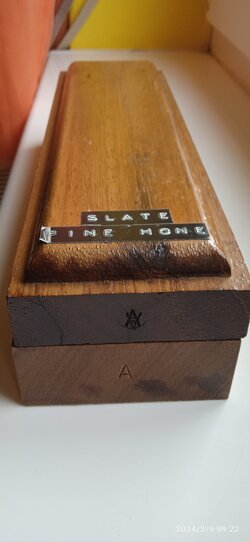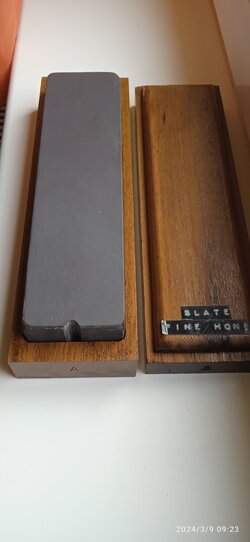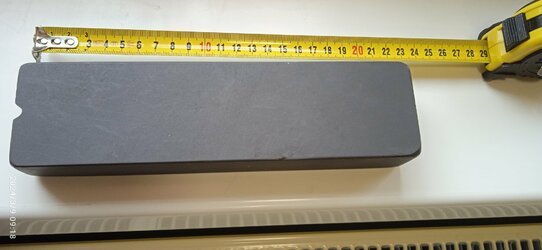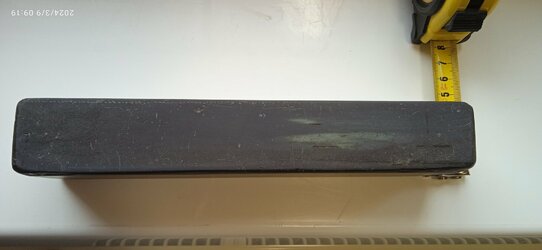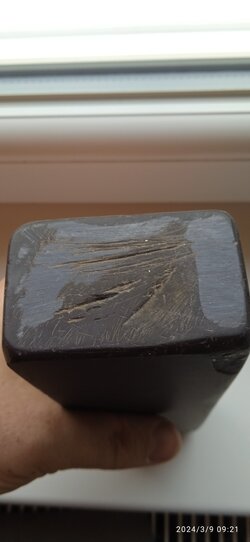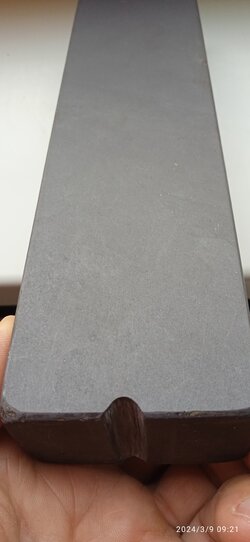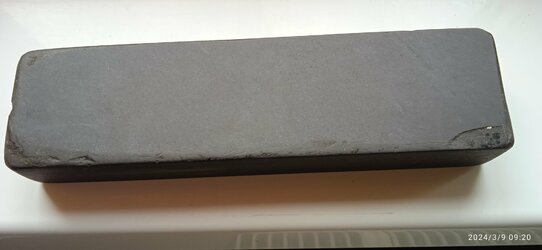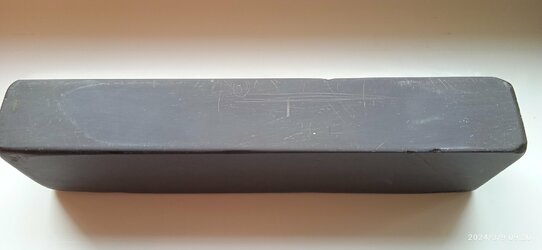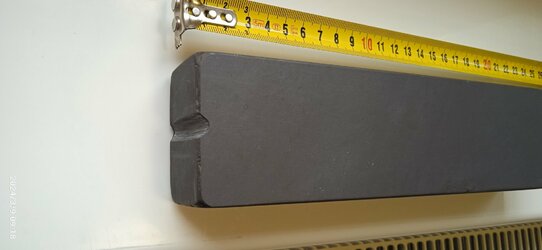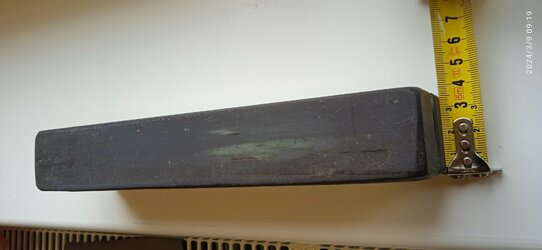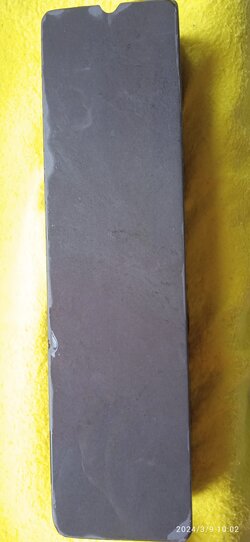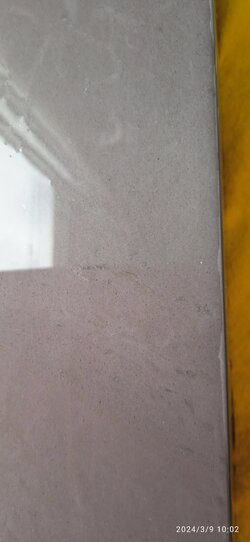Yeah min is boat shaped also quarried with a driver plane. The only thing that kept me from thinking turkey was I don't remember any sulfur smell. It even looks like a turkey on the sides though and changes color based on if it is full of oil or not. Really hard and fine and no fissures or anything like yours.They do vary pretty wildly sometimes. I've got one that's obviously pretty old, it's boat shaped so I assume quarried with a driver plane. It looks nothing like a typical turkey stones but in use its identical. It's got a calcite vein on the side of it. I purchased it from a member here.
View attachment 1808192View attachment 1808193
You are using an out of date browser. It may not display this or other websites correctly.
You should upgrade or use an alternative browser.
You should upgrade or use an alternative browser.
Mystery hones... Let's see what you have
- Thread starter kcb5150
- Start date
Nice, maybe a can get rid of some of my washitas then. They seem to be multiplying.Those speckled llyn Idwals are AMAZING knife stones when they're on the coarser side(like a washita).
I just dropped it in the SG and will give it a half a week each side. Maybe I’ll give it a Specific Gravity test and a lap when it comes out. Looks like it might be a good knife stone if it is a Washita. I can see it now I’ve looked up what they look like. It would account for the fact that the sandpaper had almost no effect. Arks are the same. Anyway I’m happy for the punt I took on it.
2 weeks in simple green and the green is now real dirty. It's surprising what came out of the rock even after a degrease. Lapped and first use. I used a Naniwa Chosera 800 to redo my western kitchen knives and finished on the Washita. A noticable improvement in the edge.

Mystery hones... Let's see what you have
I found a couple more stones I couldn’t identify. The first stone is very black with a few golden specks and the slurry from lapping is dark grey, almost black. It lapped way easier than my washita. The next is a small combo that I’m guessing is some kind of synthetic. Thanks Not...
 www.badgerandblade.com
www.badgerandblade.com
Trout stone?One of those German novaculites?
Mystery hones... Let's see what you have
I found a couple more stones I couldn’t identify. The first stone is very black with a few golden specks and the slurry from lapping is dark grey, almost black. It lapped way easier than my washita. The next is a small combo that I’m guessing is some kind of synthetic. Thanks Not...www.badgerandblade.com
Yeps, the label is correct. Slate. Fine. Hone. And that is about all you can be sure of.
I see some green splotches in there, so possibly Welsh.
Most black slates I assume are welsh or Pennsylvanian unless it know they are thuri or French. Those fat chamfers are a dead give away for the French stones.Yeps, the label is correct. Slate. Fine. Hone. And that is about all you can be sure of.
I see some green splotches in there, so possibly Welsh.
Any ideas on this one? It came from Japan but resembles no Japanese stone I am aware of. Don't think it is a Tsushima, which as I understand it, are layered.



It is grey, darker than mid-grey, when dry, and a dark green grey when wet. It is slightly sparkly. It is hard but not that hard, maybe like jnat 4-4.5. The slurry is white, and doesn't smell of much but if you get right in there and sniff it smells of fish glue. It is EXACTLY 150x50x30mm.
I vibed it would work on plain water. It does. Feels very easy to use. Leaves a fairly high polish, a scratch pattern which is fine and definitely not jnat. It took a somewhat questionable edge to one which was very comfortable if not super sharp.
Any thoughts?
It is grey, darker than mid-grey, when dry, and a dark green grey when wet. It is slightly sparkly. It is hard but not that hard, maybe like jnat 4-4.5. The slurry is white, and doesn't smell of much but if you get right in there and sniff it smells of fish glue. It is EXACTLY 150x50x30mm.
I vibed it would work on plain water. It does. Feels very easy to use. Leaves a fairly high polish, a scratch pattern which is fine and definitely not jnat. It took a somewhat questionable edge to one which was very comfortable if not super sharp.
Any thoughts?
I think many countries have exploited slate for sharpening purposes to one degree or another, albeit most not in a big way for export commercially. I have a boxed and labeled Australian slate hone somewhere.Most black slates I assume are welsh or Pennsylvanian unless it know they are thuri or French. Those fat chamfers are a dead give away for the French stones.
- Thread starter
- #2,252
Looks a lot like Pierre sauratAny ideas on this one? It came from Japan but resembles no Japanese stone I am aware of. Don't think it is a Tsushima, which as I understand it, are layered.
View attachment 1809637
View attachment 1809638
View attachment 1809640
It is grey, darker than mid-grey, when dry, and a dark green grey when wet. It is slightly sparkly. It is hard but not that hard, maybe like jnat 4-4.5. The slurry is white, and doesn't smell of much but if you get right in there and sniff it smells of fish glue. It is EXACTLY 150x50x30mm.
I vibed it would work on plain water. It does. Feels very easy to use. Leaves a fairly high polish, a scratch pattern which is fine and definitely not jnat. It took a somewhat questionable edge to one which was very comfortable if not super sharp.
Any thoughts?
One of my absolute favorite knife stones.Looks a lot like Pierre saurat
I've been sitting on this one a while. I passed it over Oli's flame a while back, but we weren't sure at the time. I've searched around for a bit more info, coming up blank.
It's a dark green, banded and speckled stone set into a lovely box. UK seller origin, so I'd guess that's where it came out of the ground. Porous, flaky structure, a bit soft, slurries easily, doesn't feel terribly fast or fine to me.
The origin and color make me think Llyn Idwal, but the porous, flaky structure doesn't seem like any Idwal I've had, but I only have two others.
There's also a black, liquidy intrusion if that rings a bell for anyone.
Showing wet and dry. You can get a sense of how quickly it draws water in and holds it. I've been tentative to use it much for fear of it breaking apart further. I think it's time for some lacquer.









It's a dark green, banded and speckled stone set into a lovely box. UK seller origin, so I'd guess that's where it came out of the ground. Porous, flaky structure, a bit soft, slurries easily, doesn't feel terribly fast or fine to me.
The origin and color make me think Llyn Idwal, but the porous, flaky structure doesn't seem like any Idwal I've had, but I only have two others.
There's also a black, liquidy intrusion if that rings a bell for anyone.
Showing wet and dry. You can get a sense of how quickly it draws water in and holds it. I've been tentative to use it much for fear of it breaking apart further. I think it's time for some lacquer.
Actually this looks almost identical to this one.
I've been sitting on this one a while. I passed it over Oli's flame a while back, but we weren't sure at the time. I've searched around for a bit more info, coming up blank.
It's a dark green, banded and speckled stone set into a lovely box. UK seller origin, so I'd guess that's where it came out of the ground. Porous, flaky structure, a bit soft, slurries easily, doesn't feel terribly fast or fine to me.
The origin and color make me think Llyn Idwal, but the porous, flaky structure doesn't seem like any Idwal I've had, but I only have two others.
There's also a black, liquidy intrusion if that rings a bell for anyone.
Showing wet and dry. You can get a sense of how quickly it draws water in and holds it. I've been tentative to use it much for fear of it breaking apart further. I think it's time for some lacquer. View attachment 1810227View attachment 1810228View attachment 1810229View attachment 1810230View attachment 1810231View attachment 1810232View attachment 1810233View attachment 1810234View attachment 1810235
Oh, we were not sure? That must’ve been a while back, and I’ve probably had loads more since.
I’d say it’s 100% Idwal. There’s significant variation in the stones we call ‘Llyn Idwal’ in terms of hardness, fineness, speed, and porosity. And black inclusions like that aren’t uncommon:
I guess I didn't expect quite the variation under the same name, but yeah I'll take it!
Are Idwal and Grecian sort of interchangeable marketing terms? I think those two words created the most ambiguity for me.
I think Idwal is/has become almost a catch all name for greenish novaculite from that part of Wales. Grecian was a marketing name from a particular company, and is a bit more specific to stones of one type/quarry.Let me rephrase, I think I wasn't sure, then got forgetful, then made you complicit in my forgetfulness
I guess I didn't expect quite the variation under the same name, but yeah I'll take it!
Are Idwal and Grecian sort of interchangeable marketing terms? I think those two words created the most ambiguity for me.
Ok that’s helpful. It’s like “every square, diamond, rhombus and rectangle is a quadrilateral”. Just a pretty generic term. I guess that makes a Grecian a quadrilateral from ~Mine X, more or less.
I’d associated Idwals with the harder, denser almost Charley like bricks. I’ll loosen my definition.
I’d associated Idwals with the harder, denser almost Charley like bricks. I’ll loosen my definition.
Let me rephrase, I think I wasn't sure, then got forgetful, then made you complicit in my forgetfulness
I guess I didn't expect quite the variation under the same name, but yeah I'll take it!
Are Idwal and Grecian sort of interchangeable marketing terms? I think those two words created the most ambiguity for me.
Haha!
But yep - there's a ton of variation in Idwals, far more so than Charnleys. Most CFs can finish a razor very nicely, but are a little bit rubbish for knives, but that's not the case with Idwals. At the top end some of them can probably finish a little finer than the finest Charns, at the bottom end they can be Washita-like.
The term 'Grecian' is an interesting one, and I'm not sure anybody knows the etymology of it in regards to whetstones. Though I wouldn't be surprised if it had something to do with their similarity to 'Turkish' stones. Historically it seems to have been used interchangeably with 'Llyn Idwal', but then also (as @Legion said) there was one company - James Howarth and Sons - that sold a particular type of Idwal under the name 'Grecian Hone'. And when I use the term I tend to use it to refer to this specific type.
They sit around the middle of the Idwal grit range, but are unusually fast. And they can be distinguished visually; it's slightly difficult to describe, but they’re very pretty, with swirly black patterns that seem to be below the surface, and so have a holographic 3d effect, which I've tried to capture in the vids below. These 'Grecian Hones' and the Penrhiw Hones (which seem to be a little coarser), would be my favourite types of Idwal.
Last edited:
Similar threads
- Replies
- 103
- Views
- 9K
- Replies
- 19
- Views
- 2K
- Replies
- 32
- Views
- 5K

